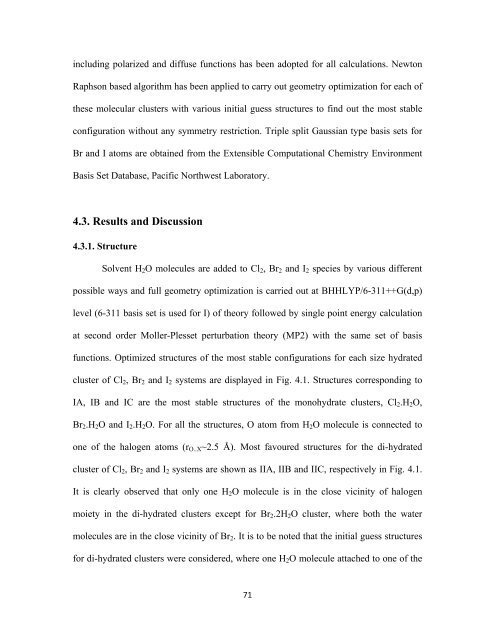CHEM01200604005 A. K. Pathak - Homi Bhabha National Institute
CHEM01200604005 A. K. Pathak - Homi Bhabha National Institute
CHEM01200604005 A. K. Pathak - Homi Bhabha National Institute
You also want an ePaper? Increase the reach of your titles
YUMPU automatically turns print PDFs into web optimized ePapers that Google loves.
including polarized and diffuse functions has been adopted for all calculations. Newton<br />
Raphson based algorithm has been applied to carry out geometry optimization for each of<br />
these molecular clusters with various initial guess structures to find out the most stable<br />
configuration without any symmetry restriction. Triple split Gaussian type basis sets for<br />
Br and I atoms are obtained from the Extensible Computational Chemistry Environment<br />
Basis Set Database, Pacific Northwest Laboratory.<br />
4.3. Results and Discussion<br />
4.3.1. Structure<br />
Solvent H 2 O molecules are added to Cl 2 , Br 2 and I 2 species by various different<br />
possible ways and full geometry optimization is carried out at BHHLYP/6-311++G(d,p)<br />
level (6-311 basis set is used for I) of theory followed by single point energy calculation<br />
at second order Moller-Plesset perturbation theory (MP2) with the same set of basis<br />
functions. Optimized structures of the most stable configurations for each size hydrated<br />
cluster of Cl 2 , Br 2 and I 2 systems are displayed in Fig. 4.1. Structures corresponding to<br />
IA, IB and IC are the most stable structures of the monohydrate clusters, Cl 2 .H 2 O,<br />
Br 2 .H 2 O and I 2 .H 2 O. For all the structures, O atom from H 2 O molecule is connected to<br />
one of the halogen atoms (r O..X ~2.5 Å). Most favoured structures for the di-hydrated<br />
cluster of Cl 2 , Br 2 and I 2 systems are shown as IIA, IIB and IIC, respectively in Fig. 4.1.<br />
It is clearly observed that only one H 2 O molecule is in the close vicinity of halogen<br />
moiety in the di-hydrated clusters except for Br 2 .2H 2 O cluster, where both the water<br />
molecules are in the close vicinity of Br 2 . It is to be noted that the initial guess structures<br />
for di-hydrated clusters were considered, where one H 2 O molecule attached to one of the<br />
71
















